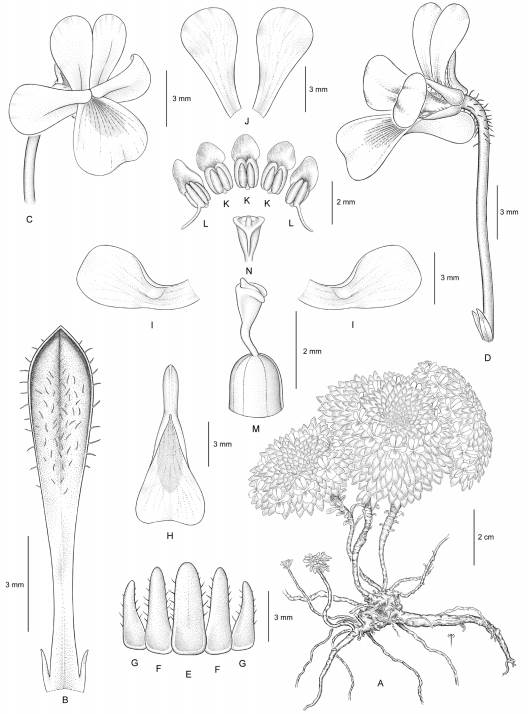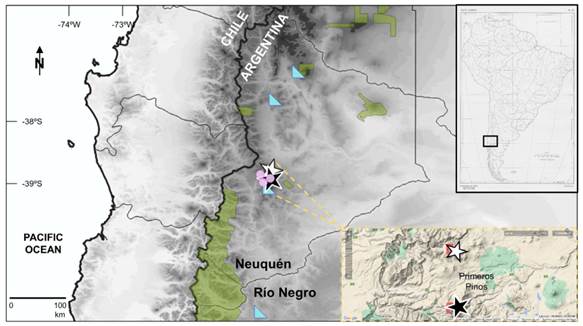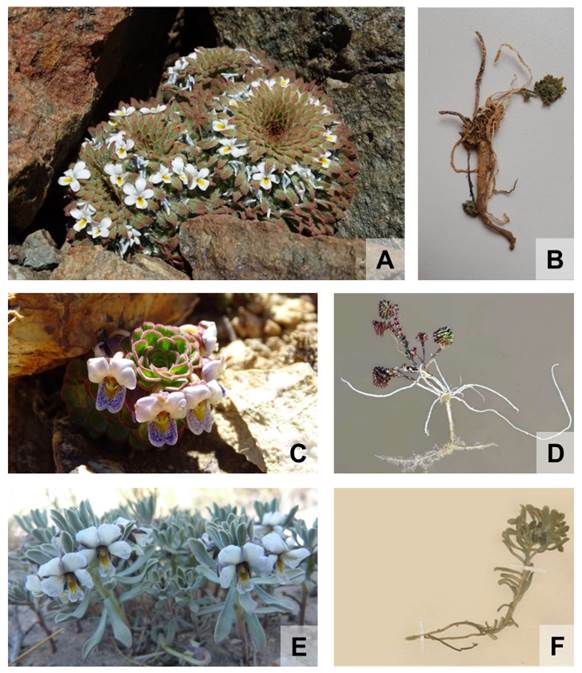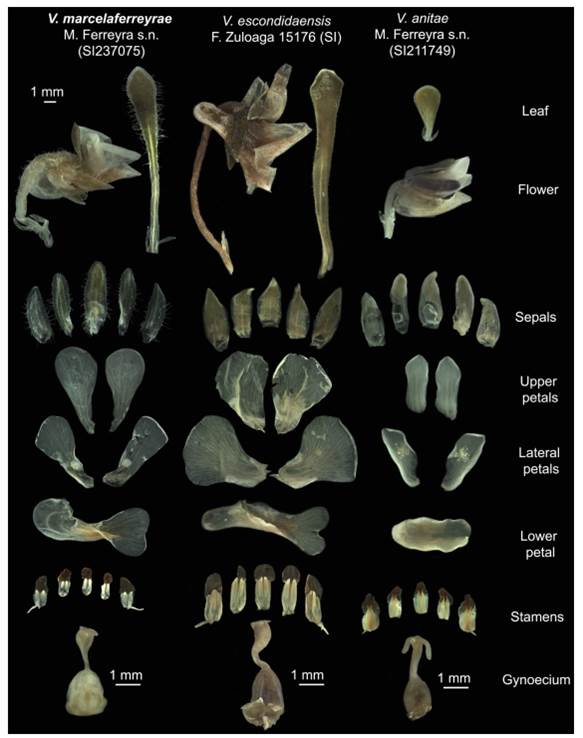INTRODUCTION
Viola L. (Violaceae) is a monophyletic genus, rich in species and with a temperate distribution. It is characterized by having striking zygomorphic flowers, peduncle non-articulated, 5 free petals, the bottom one obcordate, emarginated, and spurred, 5 free sepals with a calycine appendage, and 5 stamens, the two lowest calcarate (Ballard et al., 1999; Tokuoka, 2008; Wahlert et al., 2014; Marcussen et al., 2015; 2022). This genus is represented in the Southern Cone of South America for what is currently recognized as two subgenera, i.e., subg. Viola and subg. Neoandinium Marcussen, Nicola, Danihelka, H.E. Ballard, A.R. Flores & J.M. Watson (Watson et al., 2021; Marcussen et al., 2022). During trips to different mountains of Sierra del Chachil in the center-west of the Neuquén Province in the Southern Andes of Argentina, a tiny, white-flowered rosette camouflaged among the rocks was collected in the summits of Cerro Atravesada and Cerro Palau Mahuida in the summer of 2020 and 2021. The newly discovered species is circumscribed within subg. Neoandinium for being a subacaulous rosette with imbricate leaves, peduncle as long as mature lamina, lamina with pseudopetiole, nectariferous appendage of the two lower stamens filiform, and style at apex capitate, beardless, and crested (Marcussen et al., 2022). The currently 114 species described to date and included in this subgenus are commonly known as Andean rosulate violas, since the vast majority inhabit in High-Andean environments (Watson et al., 2021; Marcussen et al., 2022).
Most of the Neoandinium species are micro- endemics with very narrow distribution ranges and categorized as threatened (Salariato et al., 2021). Human-induced disturbances in land use and climate expose these narrow endemic species to a high level of vulnerability and risk of extinction (Gaston, 1994; Cowie et al., 2022). Therefore, it is urgent to know and distinguish the South American Viola species in order to take actions regarding their conservation in the context of the rest of the phylogenetic diversity of each region.
It may come as a surprise to find out how many new species have been described in recent years for the Andean Viola, many of them collected only once or a few times in a very restricted area (e.g. Ballard & Iltis, 2012; Watson et al., 2013, 2018, 2019; Gonzáles & Cano, 2016; Watson, 2018; Gonzáles & Molina-Alor, 2020; Gonzáles et al., 2022). But it must be considered that these lineages have been evolving for approximately 30 million years (Marcussen et al., 2022) in a highly changing, complex, diverse, and fragmented environment such as the Andes, and a high diversity of species is to be expected. In addition, these plants usually grow in areas of difficult access, especially on mountain tops, and often go unnoticed by the human eye since they are small, are at ground level, and blend in the color of their leaves with the substrate. Moreover, South American Viola has only been fragmentarily and intermittently studied so far. After the comprehensive but preliminary investigation by the specialist in the genus, Wilhelm Becker from the Berlin Herbarium (Becker, 1925), the study of South American Viola taxa was resumed in country catalogs, regional floras, and articles, although still patchily (e.g. Baehni & Weibel, 1941; Sparre, 1949, 1950; Marticorena & Quezada, 1985; Rossow, 1988; Watson, 1994; Rossow et al., 2003; Sanso et al., 2003, 2008; Watson & Flores, 2007, 2020; Nicola, 2017; Nicola et al., 2018; Rodriguez et al., 2018; Watson et al., 2018; Ferreyra et al., 2020). More recently, a concerted effort has been initiated to investigate comprehensively the South American Viola groups also in the context of the whole genus (Watson et al., 2021; Marcussen et al., 2022). Nonetheless, a complete phylogeny has not yet been published for the South American groups of Viola; therefore, the new taxa that are being discovered cannot yet be placed in a phylogenetic context, although they can be assigned to sections based on classical taxonomy (Watson et al., 2021).
In the context of all the introduced above, we here describe and illustrate the new endemic species from the high Andes of central-western Neuquén, Argentina, Viola marcelaferreyrae, and compare it with its morphologically and geographically allied species. A distribution map, a discussion about the section where the new species should be placed provisionally, and a key to the species of the section are also presented. Finally, we preliminary asses the conservation status of the new species.
MATERIALS AND METHODS
We examined herborized material and field photos of the new species. Also, we studied the known closely related species present in Argentina and Chile growing near to the area of discovery. These were studied from herbarium specimens from the herbaria CORD, LIL, MERL, and mainly SI (acronyms following Thiers, 2022), digital images available on the JSTOR Global Plants website(http://plants.jstor.org), and field photos. We consulted the protologues of related species and available literature on the subject, some of which were cited in this study. Plant material was examined under a stereoscopic microscope (Wild Heerbrugg, Switzerland) after its softening with hot water and dissection; therefore, the dimensions indicated in the taxonomic treatment correspond to rehydrated material. Photographs of the dissected material were taken using a stereoscopic microscope with a built-in camera (Nikon SMZ800) and using the software Micrometrics SE Premium 4 (Accu-Scope Inc., Nueva York). For the designation of the type material and for the spelling of the specific epithet of the new species, we followed the International Code of Nomenclature for algae, fungi, and plants (Turland et al., 2018). The distribution map was created in QGIS 3.22.5 “Białowieża” (Quantum GIS Development Team, 2022) using geographic coordinates of herbarium specimen labels whenever available. Specimens lacking geographic coordinates were georeferenced using the most likely location estimated through Google Earth (http://earth.google.com/).
We also assessed a preliminary threat category for the new species based on the IUCN Red List categories and criteria v3.1 (IUCN, 2012) following the IUCN guidelines v14 (IUCN, 2022). The category was evaluated under criterion B, based on the geographic distribution, useful when the distribution of a taxon is only known from herbarium specimens with scant information on population size and potential continuous decline or other characteristics of the state of the populations (Nic Lughadha et al., 2018). We calculated the area of occupancy (AOO, sub-criteria B2) based on the only two known occurrence sites for the new species and using the default IUCN recommended cell width of 2 km in GeoCAT (Bachman et al., 2011).
RESULTS
Taxonomic treatment
Viola marcelaferreyrae Nicola, J.M. Watson & A.R. Flores, sp. nov. TYPE. ARGENTINA. Neuquén: Depto. Picunches, cumbre del Cerro Atravesada, al sur de Primeros Pinos, 38º 57’ 4’’ S, 70º 37’ 18’’ W, 2585 m s.m., 21-XII-2020, M. Ferreyra s.n. SI-237075 (holotype SI!, barcode #169999; Fig. 1).
Diagnosis. Similar to Viola anitae but with larger rosettes, leaves imbricated with apex acute-acuminate, and petals white and glabrous. Also resembles V. sacculus, but differs by having underground stolon-like perennating axes. It differs from both most similar species by presenting lamina, peduncle, and sepals hairy, and style crest with two short and thin protractions.
Rosette-forming perennial herb, rosette 2-4 cm diameter when mature; main stem ca. 3 mm diameter, generally branched; long stolon-like perennating axes growing underground from the main stem, white, swollen, full of water when fresh, yellowish and thin when dry. Leaves spirally arranged and imbricate, 7-20 × 1.5-2 mm long in total when mature, including lamina and pseudopetiole; lamina oblanceolate to spatulate, semi-flexible, upper surface with white long hairs towards the central zone, lower surface glabrous, apex from acuminate or acute on upper leaves to obtuse on lower leaves, margins entire, red in living plants, with white long hairs towards the middle and the base, with base attenuate in pseudopetiole; pseudopetiole glabrous; stipules present, persistent, linear-triangular, ca. 1 mm long, margins entire, glabrous. Flower ca. 8 mm high × 8 mm wide when mature on living plants, emerging briefly above or below foliage, white with yellow throat, with purplish-blue tints on the back of the petals; peduncle ca. 11 mm long, hairy towards its apex; bracteoles present, persistent, inserted towards the bottom of the peduncle, linear-lanceolate, ca. 2 mm long, margins entire, glabrous; all sepals with margins hairy, and with basal calycine appendage rounded, short, ca. 0.3 mm; upper sepal oblong, ca. 4.5 × 2 mm, apex obtuse to rounded and reddish; lateral sepals oblong, ca. 5 × 1.5 mm, apex obtuse to rounded; lower sepals oblong, ca. 4 × 1.5 mm, apex acute to obtuse; upper petals oblong-spatulate, ca. 7 × 3.5 mm, glabrous; lateral petals oblong-spatulate, folded in the middle zone of the upper margin forming a protrusion towards the throat, ca. 7 × 3.5, glabrous; lower petal panduriform-obcordate, emarginated at apex, folded at base forming a channel towards the spur, ca. 7 × 3.5, glabrous; spur ca. 3 mm long, rounded. Stamens ca. 2.5 mm long; apical connective appendage ca. 1.5 mm long, brownish; basal nectariferous appendage of lower stamens filiform, ca. 1.5 mm long. Ovary ca. 2 mm long, glabrous; style claviform, ca. 1.5 mm; style crest triangular in upper view, with two divergent, short, thin, linear lateral protractions or small lobes; stigma rostrate, prominent. Capsule ca. 6 mm long; seeds ca. 2.5 mm long, light brown when immature, dark brown to black when mature, elaiosome absent.

Fig. 1 Viola marcelaferreyrae. A, habit. B, leave with stipules, upper surface. C, flower, semi-frontal view. D, flower with peduncle and bracteoles, lateral view. E, upper sepal, dorsal surface. F, lateral sepals, dorsal surface. G, lower sepals, dorsal surface. H, lower petal, ventral surface. I, lateral petals, ventral surface. J, upper petals, ventral surface. K, upper stamens, ventral surface. L, lower stamens showing the basal appendage, ventral surface. M, gynoecium showing style crest from semi-lateral view. N, style crest, frontal view. M. Ferreyra s.n. SI-237075 (holotype SI).

Fig. 2 Distribution map showing the known occurrence sites of Viola marcelaferreyrae (two stars; the type locality of Cerro Atravesada larger, filled in black, with white border, and the locality of Cerro Palau Mahuida smaller, filled in white, with black border) and the allied species, V. anitae (three pink dots) and V. escondidaensis (four light-blue triangles) from sect. Rhizomandinium. Zones in green in the main map refer to protected areas of Argentina. At the upper right, a map of South America showing the distribution area of the species marked with a black rectangle. At the bottom right, the GeoCAT map showing the two known occurrence sites for V. marcelaferreyrae, north and south of the locality of Primeros Pinos in Neuquén Province, and their respective area of occupancy (red squares). Color version at http://www.ojs.darwin.edu.ar/index.php/darwiniana/article/view/1092/1275
Distribution and habitat. Viola marcelaferreyrae is endemic to the center-west of the Neuquén Province, in the southern Andes of Argentina. It is known for the summits of Cerro Atravesada and Cerro Palau Mahuida in Sierra del Chachil, around 2500 m altitude (Fig. 2). It grows in the High-Andean region, among the rocks and inhabits with Armeria maritima (Mill.) Willd., Cerastium arvense L., Combera paradoxa Sandwith, Menonvillea rigida Rollins, Nassauvia lagascae (D. Don) F. Meigen, Oxalis erythrorhiza Gillies ex Hook. & Arn., Poa obvallata Steud., Senecio portalesianus J. Remy, and Viola anitae J.M. Watson, among other species.
Phenology. Flowering in the Southern Hemisphere summer. Seen in bloom in December at Cerro Atravesada, and in fruit in February at Cerro Palau Mahuida.
Etymology. We dedicate this new species affectionately to the Argentinean botanist Marcela Ferreyra, who was the discoverer of the new Viola presented here and collected the original material. Born in 1959 in Rosario (Santa Fe Province), brought up in Río Cuarto (Córdoba Province), and working mainly at Universidad Nacional del Comahue and Universidad de Río Negro (Bariloche, Río Negro Province), she has contributed and continues to contribute much to the understanding of the austral Andean-Patagonian flora in general and Viola in particular. She has achieved this through scientific articles (e.g. Ferreyra et al., 1998), books (e.g. Ferreyra et al., 2020), her role as a professor, science popularizer and tour guide, and her wonderful field photos (e.g. https://www.flickr.com/photos/122935534@N04/). We commemorate with love and gratitude these contributions by providing this novelty with the epithet of Viola marcelaferreyrae.
Conservation status. Hitherto, Viola marcelaferreyrae is only known from two small populations on the summits of the Atravesada and Palau Mahuida mountains (Fig. 2). The most important population is that of Cerro Atravesada, whose summit is reached by up to 100 tourists per day every summer, putting the population at high risk of survival due to possible trampling or plan extraction. Cattle does not reach the top because it is a rocky area with very little plant cover. The population of Cerro Palau Mahuida is smaller but safer from hikers as they must pass through military territory and a private ranch to reach the summit. In addition, military activities and cattle grazing are carried out at lower altitudes. It should be noted that neither of the hitherto known occurrence sites for the new species falls within the boundaries of any protected area. Finally, there is always a risk of volcanic eruptions throughout the Andean zone. Regarding the IUCN Red List categories, criteria, and guidelines (IUCN, 2012, 2022), when relied only on the two known occurrence points registered for the new species and with the impossibility of compute the polygon of extent of occurrence (EOO), we report an area of occupancy (AOO) of 8 km2. Therefore, following the B2ab(ii) criteria of the IUCN Red List of threatened species, taking into account the reduced area of occupancy of less than 10 km2, and pondering Sierra del Chachil as one locality or a single distinctive geographic and ecological area in which a single threatening event (i.e. tourism or volcanism), can rapidly affect all individuals of the present taxon, V. marcelaferreyrae is provisionally categorized as Critically Endangered (CR).
Other specimen examined (paratype)
ARGENTINA. Neuquén. Depto. Picunches, Cerro Palau Mahuida al norte de Primeros Pinos, en altas cumbres, 38º 48’ 32’’ S, 70º 37’ 35’’ W, 2484 m s.m., 3-II-2021, M. Ferreyra s.n. SI-234419 (SI, barcode #167608).
DISCUSSION
The presence of a fleshy perennating organ in living plants of Viola marcelaferreyrae suggest that this species may store water and nutrients to sustain during unfavorable seasons or conditions such as drought. This is an adaptation that can occur in perennial herbaceous plants that must avoid harsh winter conditions of freezing temperatures and snow cover (Lubbe et al., 2021), situations that commonly take place in Andean mountain summits as Cerro Atravesada and Cerro Palau Mahuida, where the new species was found.
Due to the presence of underground stolon-like perennating axes, V. marcelaferreyrae should be assigned to sect. Rhizomandinium J.M. Watson, A.R. Flores & Marcussen, which also includes V. anitae and V. escondidaensis W. Becker. Likewise, these species possess lamina with entire margins, have a style crest with two lateral divergent lobes, and are present in western Neuquén Province (Watson & Flores, 2011; Watson, 2018; Watson et al., 2021; Marcussen et al., 2022; Fig. 3 and 4). An interesting fact is that V. anitae coexists with V. marcelaferreyrae in Cerro Atravesada, being the type locality of both (Watson, 2018). Due to the habitat similarity shared between V. anitae and V. marcelaferreyrae, it would be interesting to carefully survey the other mountains where V. anitae also lives, cerros Cochico and La Ventana in Sierra del Chachil, both with peaks that reach approximately the altitude at which the new species grows (ca. 2500 m a.s.l.). Moreover, the uncertain type locality of V. escondidaensis in “Valle Escondida” was traced in an area between Zapala and Aluminé (Watson & Flores, 2011), probably near or in the Chachil range. Although sect. Rhizomandinium was defined as a separate group for being mostly glabrous herbs as well (Watson et al., 2021), V. escondidaensis can present glabrous to hairy leaves (Watson & Flores, 2011; Nicola, 2017). In this context, V. marcelaferreyrae could fit sect. Rhizomandinium despite having notably hairy leaves. Since underground structures of most Andean Viola species are unknown or little known, and that sections based on classical taxonomy (Watson et al., 2021; Marcussen et al., 2022) have not yet been full tested in a phylogenetic context, this assignment may be non-definitive. It is very usual that underground structures of perennial Andean Viola herbarium material are incomplete or absent. This could be due to the difficulty involved in extracting these structures, which are often very voluminous and deep, to a lack of knowledge of their systematic importance, or to the decision not to extract much material in pursuit of its conservation. The lack of knowledge about the underground structures of Andean Viola may cause or have caused misclassifications at the supra-specific level and this should be considered when collecting plants and classifying taxa.

Fig. 3 Viola marcelaferreyrae (holotype). A, field photo taken by Marcela Ferreyra in the type locality. B, photo of dry material showing the underground structures. Viola anitae. C, field photo taken by Marcela Ferreyra [M. Ferreyra s.n. SI 211749 (SI)]. D, photo of fresh material showing the underground structures [digital image copied from the original publication (Watson, 2018)]. Viola escondidaensis. E, field photo taken by Marcela Ferreyra. F, digital image copied and cropped from the phototype at JSTOR Global Plants website showing the underground structures [H. F. Comber 241 (K 000535088)]. Color version at http://www.ojs. darwin.edu.ar/index.php/darwiniana/article/view/1092/1275
From the point of view of general morphological appearance, V. marcelaferreyrae could otherwise be related to the also white-flowered, V. sacculus Skottsb. from sect. Sempervivum J.M. Watson & A.R. Flores. The species of this section are characterized for being perennial or annual subacaulous, glabrous, imbricated rosette- forming herbs, with lamina entire or shallowly subcrenulate, and apex acute to obtuse (Watson et al., 2021; Marcussen et al., 2022). The diagnostic character of sect. Sempervivum of being glabrous is not fulfilled in the case of V. marcelaferreyrae, and therefore should be treated as an exception. In addition, most “sempervivoids” have a coriaceous, rigid lamina, especially those that inhabit the Andes of central Argentina and Chile southwards, which neither fit the semi-flexible lamina of the new species. Despite the morphological resemblance between V. marcelaferreyrae and V. sacculus due to the fact that both are perennial herbs with rosettes of similar general appearance, having lamina more or less spatulate with entire margins, and flower white with a yellow throat, these two species differ in diagnostic characters. While V. marcelaferreyrae presents underground stolon-like perennating axes, pubescent lamina, sepals, and peduncle, and style crest with two short, thin, lineal lateral lobes that go backwards, V. sacculus presents a robust taproot vertically and deeply arranged, without underground stolon-like perennating axes, has glabrous lamina, sepals, and peduncle, and style crest entire to bilobed with two short and ovate lateral lobes that generally go downwards, sometimes each bilobed or with wavy margins.
Finally, considering hairiness, V. marcelaferreyrae could otherwise be included in sect. Rosulatae Reiche p.p. In this context, it would be also one of the exceptions in the section, by being perennial with entire lamina, together with the probably extinct V. niederleinii W. Becker distributed much further north, in the Nevado de Famatina in La Rioja Province, and with the raised-vein V. montagnei Gay and V. rubromarginata J.M. Watson & A.R. Flores (Watson et al., 2021), with which it has no morphological resemblance.
In conclusion, with the taxonomic, morphological, and geographic knowledge gathered up to now, V. marcelaferreyrae is provisionally placed within sect. Rhizomandinium together with its morphologically and geographically allied species, V. anitae and V. escondidaensis, and is tentatively categorized as Critically Endangered (CR). Future phylogenetic analyses will be an additional source of information regarding the classification of the species within subg. Neoandinium (Nicola et al., in prep.).
Key to the species of sect. Rhizomandinium, based on Watson et al. (2021) and Marcussen et al. (2022)
1. Plants caulescent. Stems elongated. Leaves loosely arranged (only densely arranged at the tip of the stem). Stipules absent ……………....................................................................……………………...... V. escondidaensis
1. Plants rosulate. Stems short. Leaves imbricated or sub-imbricated, forming rosettes. Stipules present and persistent .…………………………………………………………....................................................................… 2
2(1). Rosette 1-2 cm diam. when mature. Leaves sub-imbricated. Lamina glabrous, with apex mainly rounded-obtuse. Sepals glabrous. Peduncle glabrous. Petals white with irregularly scattered dark purple lines, dots, and spots; lateral petals hairy. Style crest with two divergent, lateral, long, stout, recurved lobes turned backwards …….…..… V. anitae
2. Rosette 2-4 cm diam. when mature. Leaves imbricated. Lamina hairy, with apex mainly acute-acuminate. Sepals with hairy margins. Peduncle hairy towards its apex. Petals white; lateral petals glabrous. Style crest with two divergent,
lateral, short, thin protractions or small lobes turned backwards …….........................………….… V. marcelaferreyrae












 uBio
uBio 


